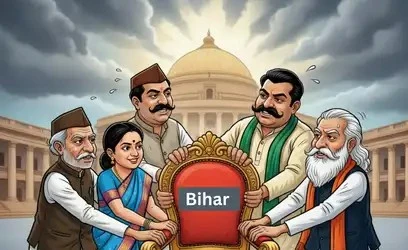Bihar Election 2025
Opinion surveys indicate that the opposition Mahagathbandhan (INDIA group) and the government National Democratic Alliance (NDA) are running a very close and unpredictable fight, leaving no one in a clear lead in the Bihar 2025 elections. The potential disruptive element of Prashant Kishor’s Jan Suraaj Part adds even more intricacy.
Also ReadThere are several main reasons why this Bihar election is significant:
- A possible watershed moment for Nitish Kumar: After over 20 years in office, the long-serving chief minister is facing strong anti-incumbency sentiment and voter fatigue. His age and athleticism have become issues in the political debate.
- The emergence of a youth substitute: Tejashwi Yadav of the RJD, who is now ranked as the leading candidate for chief minister in some surveys, is considered as having a significant chance to take advantage of voter resentment and propel the opposition to power in the election.
- The arrival of a new disruptor: Prashant Kishor, a strategist who is now a politician, and his Jan Suraaj Party bring an unpredictable element that could have a big impact on the major coalitions’ vote percentages.
Who’s leading: The main contenders Bihar Election
National Democratic Alliance (NDA) in Bihar Election
- Key parties: Bharatiya Janata Party (BJP), Janata Dal (United) (JDU), Lok Janshakti Party (Ram Vilas) (LJP), Hindustani Awam Morcha (HAM) and Rashtriya Lok Morcha (RLM).
- Strength: The alliance hopes to benefit from the BJP’s organizational strength and Prime Minister Narendra Modi’s popularity. It also relies on the women’s vote, which proved crucial in the 2020 election.
- Challenges: The alliance faces strong anti-incumbency against Nitish Kumar, and recent surveys show many voters prefer Tejashwi Yadav as the next Chief Minister. There have also been internal alliance tensions over seat-sharing.
Mahagathbandhan (INDIA bloc) in Bihar Election
- Key parties: Rashtriya Janata Dal (RJD), Indian National Congress (INC), and Left parties including CPI(ML).
- Strength: The alliance is led by Tejashwi Yadav, a popular youth leader. It has a loyal Muslim-Yadav (MY) voter base and hopes to attract young and backward-caste voters frustrated with the current government.
- Challenges: The alliance has been bogged down by internal friction and seat-sharing negotiations. It must overcome the legacy of RJD’s past governance and manage family disputes involving Lalu Prasad Yadav and his sons.
Jan Suraaj Party (JSP) in Bihar Election
- Key figure: Political strategist-turned-politician Prashant Kishor.
- Significance: Operating independently, the JSP aims to challenge the established political duopoly by offering an alternative to disillusioned voters.
- Impact: Polls indicate the JSP could act as a spoiler, eating into the vote shares of both major alliances and potentially altering the outcome.
Why this Bihar election matters
The power of women voters: Female voter turnout has consistently been higher than male turnout in recent elections, making women a decisive voting bloc that parties are actively courting with specific promises.
A verdict on Nitish Kumar’s legacy: After frequent alliance shifts, the election will test if Nitish Kumar’s image as “Vikas Purush” still resonates with voters or if fatigue and dissatisfaction will lead to his ouster.
Shifting political narratives: The contest will reveal whether long-standing caste politics or new narratives focused on youth, jobs, and development will prevail.
A barometer for national politics: As a key Hindi heartland state, Bihar’s election is an important indicator of voter sentiment with national implications for both the NDA and the INDIA bloc.
Bihar 2025 elections are the crucial issues dominating public discourse. High youth unemployment remains a top concern, especially with many young people leaving the state to find jobs elsewhere. The opposition’s promises of employment resonate strongly with this demographic and could sway the vote in close contests. The NDA, in turn, is highlighting its development and infrastructure projects to showcase progress.
The economy, including issues of development and growth, is another significant factor. While the state has shown strong economic growth figures, the challenge lies in translating this into improved per-capita income and better living standards for the population. Other key issues impacting voters include the controversial voter roll revision and the impact of the liquor ban. The Jan Suraaj Party has directly addressed the latter, pledging to overturn the ban, which adds a distinct element to the campaign rhetoric.
Ultimately, the election is poised to be decided by a blend of persistent caste politics and new narratives around development and youth aspirations. The outcome will depend on whether voters prioritize the NDA’s promise of continued progress or opt for the Mahagathbandhan’s call for change. The role of the wildcard Jan Suraaj Party in potentially splitting votes or acting as a spoiler could also prove decisive.

